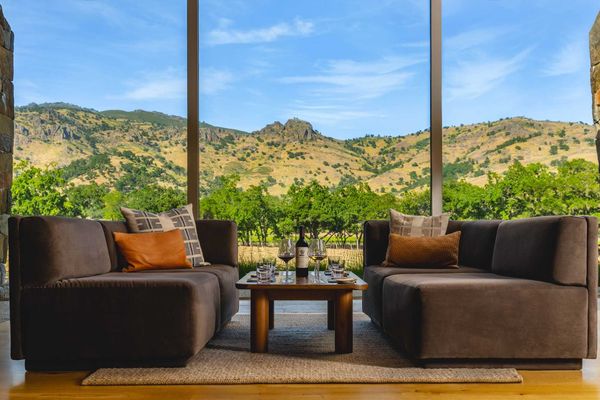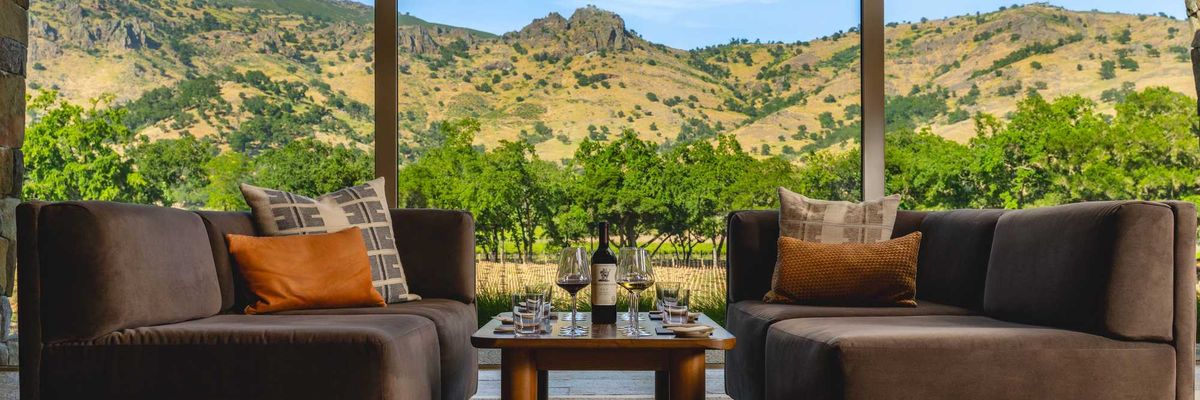When the Whitney Museum of American Art moved from the Marcel Breuer-designed edifice on the Upper East Side to its current home, a vast, eight-story Renzo Piano affair in the Meatpacking District, the square footage of its gallery space increased dramatically, so much so, that even in the midst of a heavily-attended Biennial, one occasionally finds oneself completely alone in the company of an artwork.
On a weekday morning in mid-May, I found myself in just such a position, alone in a corner of an exhibition space with a video piece titled Listed under Accessories, in which the Jamaican-born, Brooklyn-based artist Dave McKenzie engages in a strangely mesmerizing interaction with a large pane of glass.
Unnerving, discomfitingly comical and mysterious, it thoroughly captured my curiosity, as did the Ohio-born, Brooklyn-based artist Ralph Lemon, whose vibrant, tapestry-like paintings, some composed of more than a hundred disparate images, brimmed with energy; and Guadalupe Rosales, a Redwood City native whose nighttime studies of L.A. called to mind the nocturnal still-lifes of the San Francisco Bay Area-based photographer Todd Hido.
As I made my way through the museum lobby toward the exit, it occurred to me that the last time I'd gone to the Biennial, in 2002, it was mainly to see the work of another Bay Area artist, Chris Johanson, who was associated with San Francisco's so-called Mission School. It was a minor coincidence, perhaps, but one of a series of connections, some tenuous, others less so, that seemed to tie the cities together, at least in my imagination.
A long time ago, when it came time to choose the city in which to carve out a life, San Francisco seemed an almost inevitable choice. At the time, I was of a somewhat bohemian mindset, and The City an even more bohemian place. Equally significant was the fact that much of San Francisco had the feeling of a small town, and as such, seemed a perfect place for a kid from a small town to slowly and cautiously evolve into an ever more urban creature. Many years later, however, with that evolution essentially complete, there comes a periodic craving for a certain intensity of urban experience that San Francisco, for all its wonders, doesn't quite satisfy. Which is precisely when I clamber aboard the nearest nonstop flight out of SFO, and alighting six hours later at JFK, hail a cab for Manhattan.
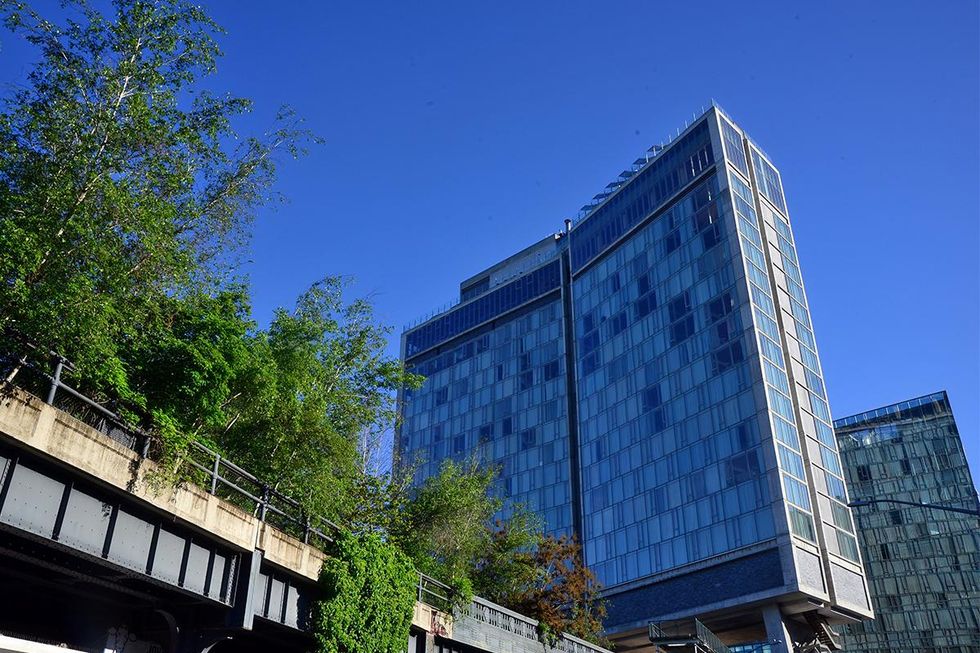
The coordinates this time were West 13th and Washington Street -- The Standard, High Line, a boutique hotel housed in a slim, concrete and glass tower that straddles the High Line, an abandoned section of elevated railway turned elevated walkway, which, since its debut in 2009, has become a major, if quietly understated attraction.
Like every room in The Standard, High Line, the compelling feature of my 12th-floor unit -- small, but big by New York standards, and playfully furnished -- was its wall of floor-to-ceiling windows, in this case facing Downtown. For I don't know how long, I gazed at the skyline, now dominated by the shimmering, 1776-foot bulk of One World Trade Center, and the mesmerizing tidal undulations of the final stretch of the Hudson, here and there cutting its surface, a Coast Guard patrol, a Circle Line cruiser, and tracing its course from 800 feet up, snub-nosed and swift, the occasional jet helicopter.
As much as I'd heard about the vistas, the real reason I chose The Standard was its proximity to Pastis, an uncanny re-creation of a Parisian bistro that I'd developed a habit for some years ago, to the extent that now, no visit to New York feels complete without a pilgrimage. Blessedly, it survived the pandemic, thanks to a thoughtfully-designed outdoor seating area, where, on a splendidly fresh and sunny afternoon, I met a friend for lunch.
The friend is a former San Franciscan, who, were he not raising a family and teaching at Juilliard and playing for the Met Opera Orchestra, would probably still be a San Franciscan. That he is not is a topic of frequent lamentation, although I think he takes some solace in the fact that it was primarily through his urging, and through his tales of The City, that I became one myself.
With a clink of my 2018 Damien Moyer L'Extra Brut (pale gold with a fine sparkle and a delicate, honeyed finish) against his Café Ivre (a bitter-orange-liqueured twist on an espresso martini) we set upon a phalanx of mind-bendingly fresh Island Creek oysters from Duxbury, Massachusetts, whose intense brininess, relative to, say, a Hog Island Sweetwater, led me to wonder if the Atlantic is somehow saltier than the Pacific. And then a pistachio-studded pâté de campagne and a succulent tuna crudo garnished with a tangy sauce ravigote and finished with a scattering of sea salt.
Our server then produced a mouthwateringly juicy Crémant de Bourgogne Brut Rosé from Victorine de Chastenay, the perfect accompaniment to a crisp-skinned and wonderfully tender grilled branzino with olive tapenade, and a delectable lobster frites—the colossal crustacean split from bow to stern, and drenched in garlic butter with green herbs. Our appetites supercharged, we polished off a plate of profiteroles doused in a bittersweet chocolate sauce, and a baba au rhum, and then a pair of pastis whose bright, anise punch energized and liberated the mind.
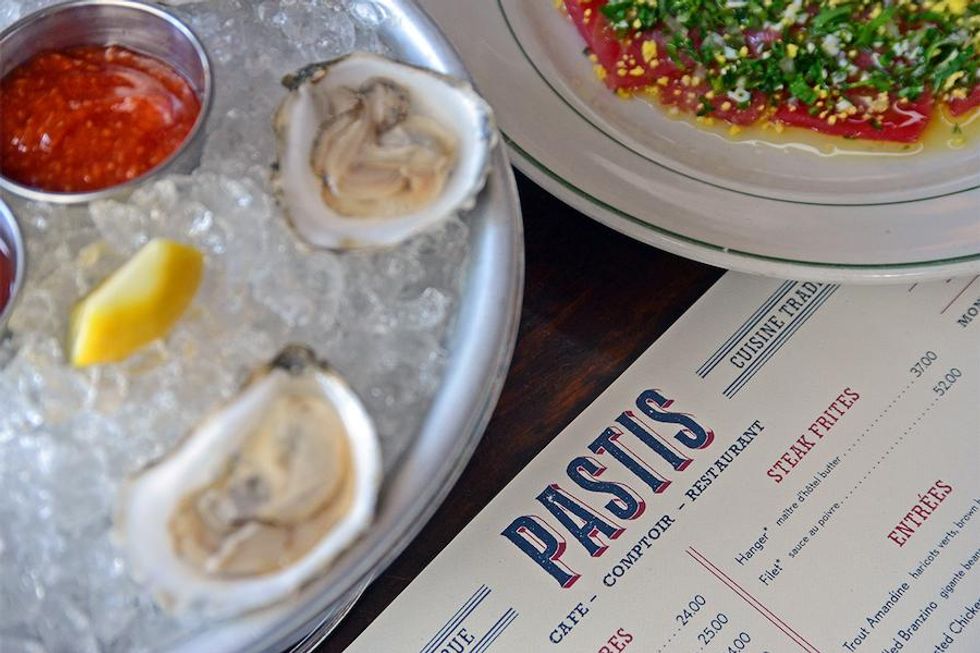
As my friend headed uptown, I headed over to Hudson River Park, a 550-acre esplanade and estuarine sanctuary that stretches from West 59th Street to the northern edge of Battery Park City in TriBeCa. Walking south along the riverfront, which on this particular stretch was packed with sunbathers and picnickers lounging in the grass, I found myself thinking of a chapter in Italo Calvino's Invisible Cities in which the very outline of a city takes on different forms depending on the nature of one's approach. To a camel driver approaching Despina from the desert, its silhouette resembles that of a ship laden with exotic goods, poised to set sail for distant ports with all their pleasures and promises, whereas from the sea, a sailor sees the humps of a camel in a caravan bound for lush oases and desert palaces in whose tiled courtyards girls dance barefoot, half hidden by veils.
Regardless of the vantage, Manhattan usually strikes me as an agglomeration of stalagmites, although an unusual species whose substance was hauled up from below rather than deposited from above. In spite of a seeming dearth of undeveloped land, they continue to rise, some, like the oligarchic spires at Central Park South, whose needle-thin proportions seem to flout the laws of physics. San Francisco has its spires, of course, but they are more an aberration than the norm in a city whose low-key skyline calls to mind a colony of barnacles exposed by a retreating tide.
My first approach to New York, or at least the first I remember, was from the sea, aboard an ocean liner from the U.K., ocean liners in those days being the most economical form of trans-Atlantic transport. I have only the vaguest recollection of the skyline, though, having been preoccupied with the Midtown pier where my father's parents were waiting for our rendezvous. I found myself wondering what my grandparents' parents might have seen in the city's outline as they steamed up the Hudson with preconceptions of architecture formed in their respective villages in Eastern Europe.
As I approached the harbor, I felt a catch in my throat as a figure came into view across the water. She was far away and small, but even from a distance she radiated power. And in an era in which offering refuge to a stranger is seen as a radical act, one could almost mistake her upraised torch for a fist raised in protest.
Stopping for a rest at The Battery—once the hunting and fishing grounds of Manhattan's first inhabitants, the Lenape and Munsee Indians—I pondered the statue, and Ellis Island, a mere speck in the harbor that in more lenient times served as a gateway to more than 12 million immigrants. New York City, for its part, has lost none of its generosity, or its magnetism. Today, more than a third of its inhabitants are immigrants.
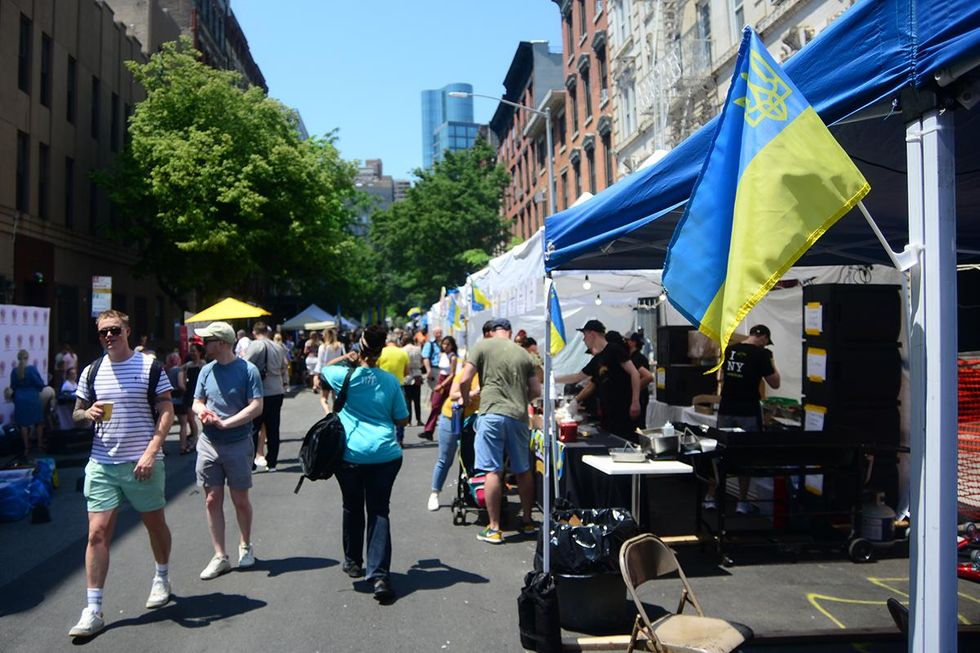
The following afternoon, I found myself among them, Ukrainians specifically, a group with whom I've always felt an affiliation, as my paternal grandparents had grown up in a predominantly Ukrainian community in Pennsylvania, and considered the language and culture their own. As with Pastis, every visit to New York requires a visit to Little Ukraine, a historic enclave in the East Village that stretches from Houston to 14th Street between 2nd and 3rd Avenue. Typically, I make a beeline for Veselka, a popular, 24-hour restaurant on the corner of 2nd Avenue and East 9th, but with pro-Ukraine sentiment at a zenith, it was mobbed, so I detoured to the considerably less touristic yet utterly charming Ukrainian East Village Restaurant, which occupies the ground floor of the Ukrainian National Home a few doors down.
Varenyky, half-moon-shaped Ukrainian dumplings, were a staple at my grandmother's table, and I ordered a plate of them, some stuffed with potato and some with sauerkraut and mushrooms, with fried onions and sour cream on the side. Nothing quite complements the dish like a cold Slavutich, an excellent Ukrainian pilsner, but due to the war, Slavutich was unavailable. The waiter offered a Zywiec, from Poland, instead. The restaurant was cool and quiet and the varenyky were scrumptious and I thought about my grandparents and the sounds of the language they spoke when they spoke of grown-up things.
The soft sounds of the language were in abundance on East 7th Street, the site of an annual Ukrainian festival hosted by the local Catholic church. A pop quartet sang somber songs, the air was redolent with the smoke of grilling sausages, and young women in embroidered blouses sold handicrafts and pastries and collected donations for Ukraine's defense. In spite of, or perhaps because of the serious undertone, the booths were doing a brisk business. I bought a poppyseed roll and ate it slowly, listening to the band, before chipping in toward the purchase of an armored medical transport and walking back across town to The Standard.
As the subway was heating up along with the weather, and as the cabs, though marginally cooler, were no more expeditious, I'd been getting around mostly on foot, an advantage of which is getting to know the places and sights in between, like a shaded stretch of Grove Street in the West Village, where a ribbon of bacon-inflected air led me, like a genie's finger, to Buvette Gastrothèque, which makes the most delightful steamed eggs with chèvre and sun-dried cherry tomatoes; or Westsider Records on West 72nd, where one can find everything from Miles Davis on vinyl to Mozart libretti, and where an inquiry about recordings by Glenn Gould somehow led to a discussion of Dusko Popov -- the Serbian double agent who was likely the prototype for James Bond—with the shop's erudite, long-time manager, Bruce Eder; or Délice Macarons on Amsterdam Avenue, which bakes the loveliest croissants and canelés (and macarons); or, as I made my way from the Upper West Side to the Upper East Side through Central Park, the slow-motion spectacle of a black-crowned night-heron stalking its pray from the lower limbs of a tree overhanging The Lake.
The more I walk, and the more I see, the more Manhattan feels like home, not only in terms of a growing familiarity, but by way of a growing curiosity about a parallel existence that might have been, or might still be. Many years ago, an east coast friend who'd been living in San Francisco for some time packed up his belongings and relocated to New York, attributing his departure to the fact that that absent the clearly demarcated seasons that exist back east, time on the west coast had a way of slipping by surreptitiously and lulling one into a sense of complacency which jeopardizes the achievement of one's creative goals. I argued, weakly, that if one paid close enough attention, one could discern subtle variations in the seasons, wet versus dry, for instance—although recently that distinction has largely ceased to exist -- and through this heightened awareness of the passage of time, go about chasing one's dreams with the requisite urgency. I understood his point, though. I, too, was losing track of time, and not being as assiduous in my work habits as I might have been. But rather than driving me to question my place of residence and mode of existence, the resulting anxiety merely drove me deeper into the sort of generalized loafing about and frittering away of income at restaurants and bars that makes life in San Francisco so pleasurable.
It was a far cry, though, from the romance of 1830s Paris as imagined by Puccini and brought to life by the Metropolitan Opera in Franco Zeffirelli's production of La Bohème. Even from the altitude of the balcony, the scenes and scenography were breathtaking, from Rodolfo and Mimì baring their souls in a rooftop garret, to the festivities at Café Momus, whose true heroine may have been the shaggy donkey, who, following the peddler Parpignol across the stage with a cart full of toys, elicited a collective gasp of delight from the audience, or the children we once were.
In Invisible Cities, Calvino writes that on arriving in a city, Marco Polo "sees someone in a square living a life or an instant that could be his; he could now be in that man's place, if he had stopped in time, long ago; or if, long ago, at a crossroads, instead of taking one road he had taken the opposite one." And while I grasp the idea, I tend to think that every city also offers a glimpse of a hypothetical future, which is in some ways tied to the notion that different cities have a way of revealing hitherto unknown facets of ourselves.
In London, for instance, I discovered a version of myself with a habit of disappearing into pubs and falling under the spell of televised rugby matches, Guinness, and plates of fish and chips and mushy peas. In Venice, I met another who could spend days poring over books on the ecology of lagoons, and hours in an armory, studying the ornamentation of 16th-century firearms. In Vienna, a third, who ate tortes and cakes as if they were going out of style, and who felt a constant, inexplicable urge to take up smoking. And in San Francisco, someone, who, in spite of an undying love for the city, spends half his waking hours dreaming of others. But whenever I think of a long-term relocation, I immediately feel a twinge of anxiety about lettuce and broccoli raab.

The phenomenon goes back to the summer of 2019, when my wife and I had dinner at Le Bernardin, the three-Michelin-star restaurant in Midtown, co-owned by Maguy Le Coze and the chef, Eric Ripert. I'd known of Le Bernardin's reputation for some time, and on learning that Ripert was a friend of the chef David Kinch and an early champion of Manresa, which I'd recently reviewed, determined it was time to go. At one point in the evening, Ripert came by to say hello. He inquired where we were from, and when we told him, he said, in a dreamy tone, "Ah, San Francisco. You have the most beautiful vegetables in San Francisco." When I asked why he thought this was, he said, "I think it is the soil, the terroir." That a chef who could have any ingredient in the world air-freighted to his door pined for the produce of San Francisco struck me deeply, and ever since, the idea of leaving the city has been bound to a fear of giving up its wonderful greens.
That dinner was a spiritual experience, and one I wanted to remind myself of, so my friend and I hopped in a cab and hopped out at West 51st and 7th Avenue just in time for a lunch reservation in Le Bernardin's lounge. An amuse bouche of a creamy, delicately smoky salmon rillette led the way to an ingot of tuna tartare surrounded by a moat of marvelously savory jus de viande and topped with tiny, crispy sea urchin toasts. At this point, Le Bernardin's wine director, Aldo Sohm (who has held the titles of Best Sommelier in Austria, Best Sommelier in America, and Best Sommelier in the World) appeared with a bewitching chardonnay from Jura, which paired spot-on with dish of poached lobster with spring vegetables in a deliciously umami miso-sake lobster broth; and a delicately-flavored dish of pan-roasted Dover sole atop a so-called "Potato Cloud" and garnished with pine nuts, fava beans, green almonds and a creamy citrus-extra virgin olive oil emulsion.
It was not quite our last brush with the finest of fine dining. Some years ago, I had the chance to eat at one of Joël Robuchon's restaurants in Monaco, and subsequently took an interest in the careers of the great chef's protégés, who, given the scale of his restaurant business, are numerous. Eric Ripert is one; Claude Le Tohic of San Francisco's one-Michelin-star O' by Claude Le Tohic is another. Both worked simultaneously at Robuchon's restaurant, Jamin, in Paris in the late 1980s. And although Robuchon passed away in 2018, younger disciples continue to emerge and make their mark. Not long before setting off for New York, I'd learned that a Japanese chef by the name of Mitsunobu Nagae, who worked both at Château Restaurant Joël Robuchon in Tokyo and L’Atelier de Joël Robuchon in New York, had just opened a place in TriBeCa called l'abeille, French for "the bee," and a play on Nagae's nickname, Mitsu, which is Japanese for "honey."
There was a curiously palpable sense of stillness in TriBeCa, and in the lengthening shadows, its cobblestone streets and brick facades gave the feeling of a film set between shoots. On entering l'abeille at the corner of Greenwich and Laight, we found the cast and crew, the former a distinctly cosmopolitan crowd, the latter, an energetic and enthusiastic staff, a number of them former colleagues of Nagae from L’Atelier de Joël Robuchon. The interior was intimate and inviting, luxurious but not ostentatious -- wide plank wooden floors, tasteful, exposed ceilings, and in between, cozy banquettes and curved back chairs whose irresistibly touchable velvet upholstery called to mind the seating at Robuchon's restaurant in Monte Carlo. Whether by coincidence or synchronicity, the designer, Marta Carvalho, runs her practice out of an office suite on the Embarcadero.
Nagae, who works silently and methodically at the fore of l'abeille's open kitchen, has a deft touch, his food pretty but not precious, compellingly tasty, with an easy and confident sense of arrangement and proportion. His Hokkaido scallop crudo, served beside a small sea of crème fraîche-caviar sauce and topped with a little pastry leaf and shapely scoops of beet gazpacho sorbet and caviar, was a quiet triumph; a grilled maitake with farro risotto and a rich hazelnut mousse was a dark forest of savory wonder; and a subtly beautiful dish of Maine lobster with glazed morels, green peas and morel cream demonstrated a keen understanding of the power of pure, elemental flavors. The drinks—a perfect Negroni and a Vesper worthy of Casino Royale—were lovely as well, and left me itching to pop by again for a cocktail and a nibble at l'abeille's bar, and recalling the outcome of a similarly modest plan at Angler not so long ago.
It's odd the way San Francisco bubbled up, like spring water, looking for openings. Or perhaps not, as I was beginning to understand why it might be hovering on the periphery. For among the reasons I'd made it my home was the fact that at the time, at least, it was the antithesis of the big city. But San Francisco has changed, and I suppose I must have as well, for these days, when I'm in New York, I find myself feeling more attuned to the same New Yorkers I'd once viewed as a distinctly different species. And while I imagine that their constitutions are still a bit tougher than mine, and that they're perhaps more driven and more disciplined in their habits, the gap is no longer as great as it once was.
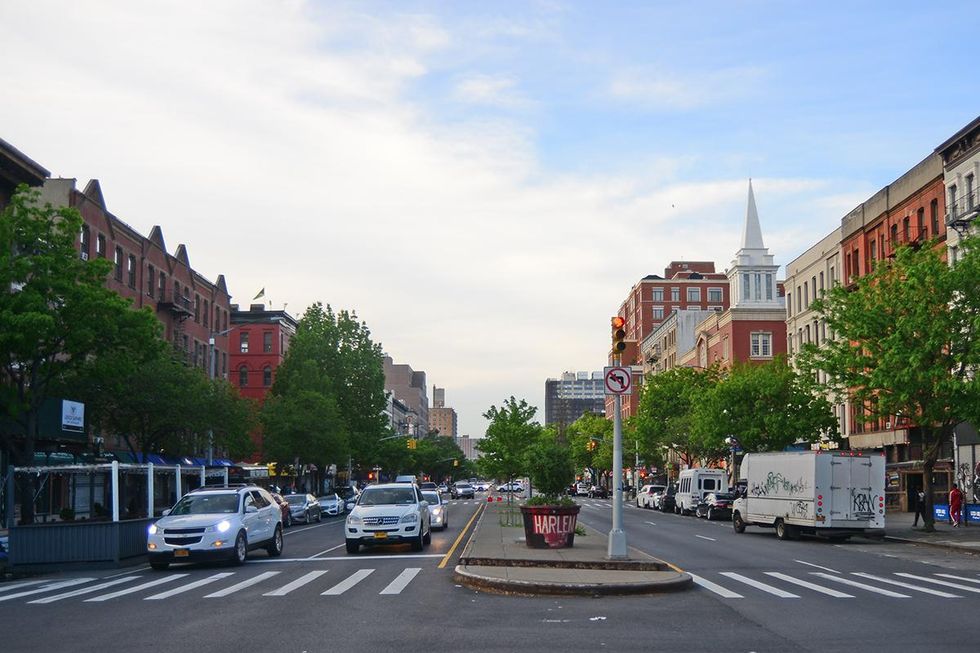
As the end of the trip drew near, I found myself thinking about Harlem. I'd been through the neighborhood many times, but never to it, so early on a Sunday afternoon I took the subway to Central Park North and started walking up Harlem's main thoroughfare, which goes by two names, Lenox Avenue and Malcom X Boulevard. The skyline was a lower in Harlem, and the sky more open. The sun beat down and I stuck to the shade of the trees, and a few blocks up, I found myself amid a cluster of shops and restaurants. I ducked into Sugar Hill Creamery, an ice cream parlor named for the "sweet life" of the nearby Sugar Hill neighborhood where many prominent African-Americans lived during the Harlem Renaissance, and which Langston Hughes memorialized in a poignant 1944 essay.
After a tangy-sweet scoop of lemon-hibiscus ice cream, I crossed the street to Archer & Goat, an inviting restaurant and bar for a spicy tequila, citrus and turmeric cocktail called the Goat. And then up the block to NiLu, a Black-owned gift shop where I leafed through Harlem 1958, a fascinating, frame-by-frame journal of a photo shoot by the art director Art Kane, which captured 57 jazz luminaries outside a Harlem brownstone.
Although I'd been hoping to hear some jazz, the prospects looked slim. Of the scores of clubs that once filled Harlem, only a few remain, and on this particular Sunday, none were open. Somewhat aimlessly, I continued up Lenox Avenue. A banner outside an African grocery—RICE CHICKEN FISH GUINEA FOWL—caught my attention, as did a parade of signs outside a hopping place called Jacob Restaurant, which seemed to list every dish on the menu.
COLLARD GREENS
MACARONI & CHEESE
FRIED CHICKEN
CORN BREAD
STEAMED CABBAGE
OXTAILS
CURRIED GOAT
LIMA BEANS
FRIED PORGY
JERK CHICKEN
CANDIED YAMS
BEEF SHORT RIBS
But it was only mid-afternoon, so I kept going, and a little further on caught a glimpse of something through a doorway. I doubled back for a closer look. It was a man fitting a mouthpiece to an alto saxophone, and behind him a modest stage with an upright piano. Two women on a bench beside the door saw me looking, and one of them waved and invited me in. The space was long and low-slung, spare, but welcoming, with a handful of chairs and tables, and past the stage, a small bar. More musicians arrived, men, like the sax player, who were in their 60s or older—a bassist, a drummer who settled in behind the kit at the back of the stage, and a pianist who began warming the keys on the well-worn piano.
I found a table at the front. A young woman appeared. I asked her the name of the place. "449 LA," she said. It was a neighborhood space for jazz and art. Her mother, Sandra—the woman who waved me in—opened it nearly 20 years ago, and now they ran it together. She offered me a drink—beer or sangria. I chose sangria. The quartet sprang to life. Their sound was loose but tight, their communication psychic. The sangria arrived. It was cold and sweet and I drank it and sank into the sound. The driving energy of Miles Davis' "Four." A languid "Girl from Ipanema." The quartet was a sextet now. A baritone sax had joined, and a dreadlocked flautist who floated above the Brazilian sea in a strange, airy upper register.
Between sets, the musicians took a break, and the bassist struck up a conversation. He wondered what had brought me there. I told him I was visiting from San Francisco and taking notes for a story. He told me 449 LA was the last such informal place of its kind in Harlem, a nexus not only for jazz, but for community. The neighborhood needed more places like it, he said, and the young people in particular needed more places like it. We talked for a while about the state of the world and our mutual bewilderment at where it seemed to be going, and shook hands as he made off for the second set.
The ensemble continued to evolve. A young man with pensive eyes took over the piano, hammering and caressing the keys with a gripping intensity; the sax player swapped his baritone for a soprano, wringing out wild arpeggios; and all the while, the flautist dipped in and out of the melodies on some mysterious higher plane. A piece came along which I felt I knew but couldn't quite recognize, the chords and harmonies sounding as if they had passed through a kind of prism, creating something half familiar, half strange. But even as I struggled to put it together, I felt a pang of melancholy, for my heart knew the song word for word.
You don't know what love is
Until you've learned the meaning of the blues
Until you've loved a love you've had to lose
You don't know what love is
I'd learned the meaning of the blues not so long ago, in fact, and still saw the world as if in a blue light, but as I found my way back down Lenox Avenue, its shade seemed somehow lighter. For perhaps I was falling in love again.





